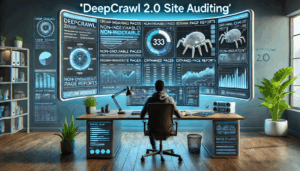
“Shopify is terrible for SEO.” That’s what I used to tell clients back in 2018.
Fast-forward to 2025, and I’m managing multi-million dollar Shopify stores that consistently outrank WooCommerce and Magento competitors. What changed? Everything.
After optimizing hundreds of ecommerce sites and watching Shopify transform from an SEO afterthought into a legitimate powerhouse, here’s the unvarnished truth about Shopify SEO in 2025—including why most “limitations” are actually user errors.
The Great Shopify SEO Evolution
Shopify has come a long way since its inception. The platform that once forced ugly URL structures like /collections/products/product-name now generates clean, SEO-friendly URLs by default. The system that ignored basic meta tags now automatically generates structured data for rich snippets.
The transformation timeline:
- 2015-2017: SEO nightmare era (limited customization, poor URL structure)
- 2018-2020: Foundation building (basic SEO features, app ecosystem)
- 2021-2023: Major improvements (native schema, speed optimization, mobile-first)
- 2024-2025: SEO powerhouse (AI features, advanced performance, enterprise-grade capabilities)
But here’s what nobody talks about: most remaining SEO “issues” with Shopify aren’t platform limitations. They’re implementation failures.
The Real Shopify SEO Story: Platform vs. User Issues
What Shopify Actually Excels At
Technical SEO Foundation:
- SSL certificates enabled by default
- Automatic XML sitemap generation
- Mobile-responsive themes as standard
- Content Delivery Network (CDN) for global speed
- Canonical tags to prevent duplicate content
- Structured data for rich snippets
Performance Optimization: Shopify is famous for its racing speed. The platform automatically converts images to WebP format (30% smaller than JPEG), uses a faster global network, and implements CDN optimization without user intervention.
Modern SEO Features:
- Automatic hreflang tags for international SEO
- Built-in robots.txt optimization
- Core Web Vitals tracking and recommendations
- AI-powered content suggestions through Shopify Magic
Where Store Owners Actually Fail
Most Shopify SEO complaints stem from user implementation issues, not platform limitations:
Image Optimization Disasters: Store owners upload 5MB product photos without resizing. Shopify’s automatic compression can only do so much. A 4000x4000px image compressed to WebP still loads slower than a properly sized 800x800px image.
URL Structure Mistakes: Choosing product names like “SKU-12345-VARIANT-A” instead of “wireless-bluetooth-headphones-noise-canceling.” Shopify generates URLs based on your input—garbage in, garbage out.
Internal Linking Neglect: Missing the massive SEO opportunity of strategic internal linking between products, collections, and blog content. Most store owners treat each page as an island.
Content Strategy Failures: Publishing thin product descriptions that don’t align with search intent. Writing “Buy our amazing widget” instead of answering “What problems does this widget solve?”
Current SEO Capabilities: What Works in 2025
Built-In Technical Excellence
Structured Data Implementation: Shopify automatically generates JSON-LD structured data for products, including name, price, availability, and reviews. Google’s rich snippets now display your products with star ratings, pricing, and stock status.
Speed Optimization Arsenal:
- Automatic image compression and format conversion
- Lazy loading for images and videos
- Minified CSS and JavaScript
- Browser caching optimization
- CDN distribution across 70+ global locations
Mobile-First Architecture: All modern Shopify themes are responsive by default. The platform uses mobile-first indexing principles, ensuring your store performs well on smartphones where 79% of users make purchasing decisions.
Advanced SEO Features
International SEO Support: Automatic hreflang tag generation for multi-language stores. Shopify handles the technical complexity of international SEO, from currency conversion to localized content delivery.
App Ecosystem Power: Over 8,000 apps extend Shopify’s SEO capabilities. Tools like JSON-LD Express add advanced schema markup, while SEO Manager automates technical optimizations.
Platform Limitations: What You Actually Can’t Control
Sitemap Customization Restrictions
You cannot manually edit Shopify’s XML sitemap. For most stores, this isn’t an issue. But large catalogs with complex hierarchies may find this limiting.
Workaround: Use proper URL structure and internal linking to guide search engines through your site architecture.
Limited Blog Functionality
Shopify’s native blogging platform lacks advanced features like:
- Gallery uploading capabilities
- NoFollow tag controls for outbound links
- Advanced comment systems
- Social sharing integrations
Reality check: Most successful Shopify stores supplement with external blogging platforms or use theme-based solutions.
Subcategory Architecture Challenges
Shopify’s flat collection structure doesn’t support traditional category/subcategory hierarchies. This can complicate large inventory organization.
Strategic solution: Use collection tags and filters to create logical product groupings without sacrificing SEO.
The 2025 Shopify SEO Strategy That Actually Works
Foundation Phase: Technical Optimization
1. Theme Selection for SEO: Choose themes with clean code structure and fast loading times. Test mobile responsiveness across devices. Popular SEO-friendly themes include Broadcast (88% recommended), Capital (92% recommended), and Enterprise (100% recommended with 5-star average).
2. URL Structure Optimization: Design product and collection URLs with target keywords:
- Good:
/products/organic-cotton-baby-clothes - Bad:
/products/sku-12345-variant-blue
3. Image Optimization Protocol:
- Resize images to appropriate dimensions before upload
- Use descriptive file names with keywords
- Write compelling alt text for accessibility and SEO
- Enable automatic WebP conversion
Content Phase: Search Intent Alignment
4. Product Description Strategy: Move beyond basic specifications. Answer user questions:
- What problems does this product solve?
- Who is it designed for?
- How does it compare to alternatives?
- What results can customers expect?
5. Collection Page Optimization: Transform collection pages into landing pages with:
- Comprehensive category descriptions
- Buying guides and comparison content
- Internal links to related products
- FAQ sections addressing common questions
6. Blog Content Integration: Create content clusters that support product sales:
- How-to guides featuring your products
- Industry trend analysis
- User-generated content and case studies
- Behind-the-scenes brand storytelling
Advanced Phase: Competitive Advantage
7. Schema Markup Enhancement: Use apps like JSON-LD Express to add:
- FAQ schema for collection pages
- Review schema for social proof
- Organization schema for brand authority
- LocalBusiness schema for physical locations
8. Internal Linking Architecture: Build topical authority through strategic linking:
- Link related products within descriptions
- Connect blog posts to relevant products
- Create hub pages that organize product categories
- Use breadcrumb navigation for clear hierarchy
Performance Monitoring: Tracking What Matters
Essential Metrics to Monitor
Google Search Console Integration:
- Track organic click-through rates
- Monitor Core Web Vitals performance
- Identify indexing issues early
- Analyze search query performance
Shopify Analytics Dashboard:
- Web performance metrics
- Search conversion tracking
- Top internal search queries
- Session quality by traffic source
Advanced Tracking Setup
Custom Goal Configuration: Set up conversion tracking for:
- Product page visits from organic search
- Newsletter signups from blog content
- Cart additions from search traffic
- Purchase completion rates by keyword
Common Shopify SEO Myths Debunked
Myth 1: “Shopify Can’t Rank for Competitive Keywords”
Reality: Shopify stores routinely rank for highly competitive terms. Examples include Gymshark (fitness apparel), Allbirds (sustainable shoes), and MVMT (watches)—all ranking for ultra-competitive product categories.
Myth 2: “You Need Expensive Apps for Basic SEO”
Reality: Shopify’s native features handle 80% of SEO requirements. Additional apps enhance capabilities but aren’t necessary for success.
Myth 3: “WooCommerce Is Always Better for SEO”
Reality: WooCommerce offers more customization but requires technical expertise. Most store owners achieve better results with Shopify’s automated optimizations than manual WooCommerce configurations.
Competitive Analysis: Shopify vs. Alternatives
Shopify vs. WooCommerce
Shopify Advantages:
- Automatic technical optimizations
- Built-in CDN and speed optimization
- Simplified implementation
- Regular platform updates
WooCommerce Advantages:
- Complete customization control
- Advanced plugin ecosystem
- Open-source flexibility
- No transaction fees
Shopify vs. BigCommerce
Shopify Advantages:
- Superior app ecosystem
- Better international SEO support
- More intuitive interface
- Stronger mobile optimization
BigCommerce Advantages:
- More built-in SEO features
- Better sitemap control
- No transaction fees
- Advanced B2B functionality
The Strategic Verdict: When Shopify Makes Sense
Ideal Shopify SEO Scenarios
Perfect for:
- eCommerce-first businesses prioritizing sales
- Teams without technical SEO expertise
- International brands requiring multi-language support
- Mobile-heavy audiences (fashion, lifestyle, consumables)
- Businesses scaling rapidly and needing reliable infrastructure
Consider alternatives for:
- Content-heavy sites requiring advanced blogging
- Highly technical products needing complex categorization
- Businesses requiring complete customization control
- Budget-conscious startups avoiding monthly fees
Your Path Forward: Making Shopify SEO Work
The question isn’t whether Shopify is good for SEO—it’s whether you’re implementing it correctly.
Success Formula:
- Foundation: Choose SEO-optimized themes and configure basic technical elements
- Content: Create valuable, search-intent-focused product and blog content
- Structure: Build logical internal linking and navigation architecture
- Performance: Monitor Core Web Vitals and user experience metrics
- Growth: Scale content creation and link building systematically
Remember: Google’s automated ranking systems are designed to present helpful, reliable information that’s primarily created to benefit people, not to gain search engine rankings. Shopify provides the technical foundation—your content strategy determines success.
The platform transformation from SEO nightmare to powerhouse is complete. The question now is whether you’ll leverage its capabilities or get caught up in outdated limitations that no longer exist.
Shopify SEO in 2025 isn’t about working around platform constraints—it’s about executing fundamentals better than your competitors. The tools are there. The question is: will you use them?





